STILLWATER AND RESERVOIR FLY FISHING GUIDE: RUTLAND WATER
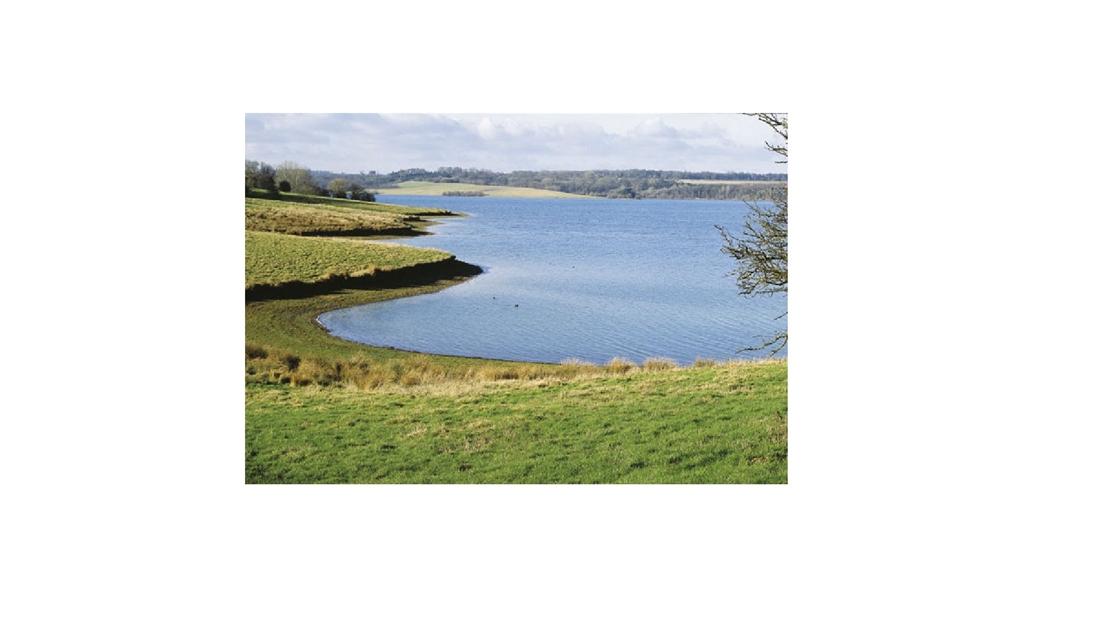
YOU arrive on the banks of 3000-acre Rutland Water for the first time. But where the hell do you start? What flies should you put on? Which spots fish best in a South-westerly? Can you wade? To help newcomers to the “big puddle” enjoy their day at our finest fishery, we’ve put together our own guide to bank fishing, listing the 24 best areas around the reservoir. So don’t be overawed by Rutland’s size. Just treat every area like a small fishery on its own and you’ll be on your way to a full bag of silver fish.
RUTLAND FLY CALENDAR
April: Black midges appear from opening day so heavy, slimline Epoxy Buzzers like the Blakeston’s with its orange cheeks, or the Spanflex with its pearly thorax, work from the start when fished in sheltered water, often under a “bung.” In deeper water, try a coral or orange Booby or marabou Damsel.
May: A greater variety of midges now start to hatch including the red and green varieties. So vary the colours of your Buzzer patterns. The classic Gold-Ribbed Hare’s Ear will now start to work as the first of the lake olives come off.
June: Trout will now be rising to hatching insects, so dry flies like the red CDC Emerger and Suspender Buzzer will take fish.
July: This can be a tough time to fish from the bank, but a dry sedge fished at dusk should bring results. Otherwise stick to a Pheasant Tail Nymph or red-headed Diawl Bach.
August: Feeding on “jelly fry” around the weedbeds now starts in earnest and the fish can become increasingly hard to tempt. Try a Silver Invicta or a Hare’s Ear.
September: The fish will now start to move inshore from deeper water and although the weed may be heavy, they can be tempted by a variety of nymphs like the Pheasant Tail, Fraser Nymph or Corixa.
October: Water temperature is now dropping and the trout now switching from insects to fry. White lures like the Cat’s Whisker or the Floating Fry come into their own.
November: By now the weed has died away and serious lure fishing takes place. All you need is a black and green Tadpole or a Minkie, easily the most successful fly at the back-end.
December: Water levels will have dropped and the water becomes gin clear over a weedfree bottom. Lures will work on the isolated shoals, or even tiny dry Black Midges for a lunchtime hatch.
UNDERSTANDING THE WIND
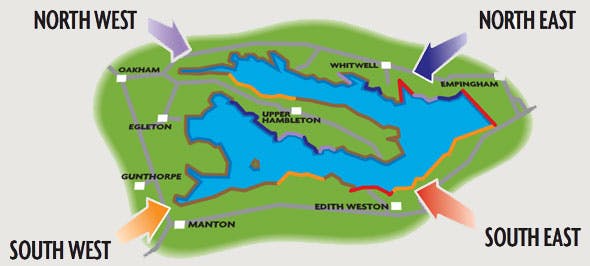
WIND
DIRECTION
BEST AREAS
Trickiest
NW
Stockie Bay, Old Hall, Yellowstone, Barnsdale
Best
SW
Normanton Bank, Transformer, Finches, Berrybutts
Warmest
SE
Dam, East Creek, Whitwell, (Normanton tricky)
Coldest
NE
Sykes Lane, Yellowstone, Old Hall Point, Green Bank
BANK fishing at Rutland is all about understanding the wind and treating it as your friend, rather than your enemy. Ideally, you want a gentle breeze blowing from left to right if you are a right-handed caster. This way you can let your flies drift along naturally with the wind.
The other option is to find a bank where the wind is blowing onto the shore. Provided it is coming in at a bit of an angle, you will still be able to cast to trout that have run down the wind, or are moving up the bank to face the drift current.
The easiest bank to fish will be the one where the wind is behind you. These protected banks can be productive early season when the fish are shoaled up in calm water, but soon become empty of fish once they start to feed naturally and have to search around for food.
Cold Northerly winds are most common early season, but they do allow easy fishing from the deeper north shore. But when a fierce Northwesterly gale rakes the water, the few areas still fishable soon fill up with anglers. This is one of the worst winds on the water and can colour up great areas.
Favourite wind with anglers is a warm moist South-westerly, provided it is not too strong. It encourages insects to hatch and blows them along the surface of the water. A stiff Southerly allows anglers to fish the North Arm bank from the Peninsula.
A hot dry South-easterly in summer will get the fish moving into deeper water. It’s then that the dam wall comes into its own. Easterlies are never a favourite wind with anglers anywhere as they can be cool, even in summer.
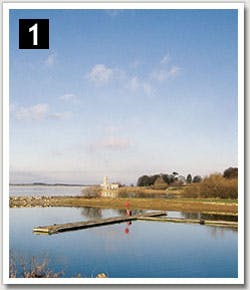
MAIN BASIN
1) The Harbour
TWO concrete breakwaters built to shelter the boat fleet offer easy fishing and casting for beginners. But space is limited on the walls and you may need to get there early. Depending on the wind direction and strength, you can either fish the deep water off the walls, or turn round and fish the shallower harbour where many specimen trout move into during Autumn and Winter after the coarse fish fry.
Best methods: Buzzers on the “bung” (bite indicator) outside the wall. Minkies and Floating Fry around the boat moorings inside the harbour
Best times: April, May, Oct, Nov, Dec
Wadeable? No
Wind effect: Fishable whatever the direction
2) Normanton
THE shallow bay between the lodge and the church can get busy with tourists on Summer weekends. So it’s best fished at the beginning and end of the season, particularly Winter. The bank on the other side of the Normanton Park hotel has two deeper areas that can be reached by bank anglers when water levels are low. Further along, deeper water runs closer to the high water mark between the two small planta¬tions. Again, a great spot for a resident fish.
Best methods: Buzzers and Damsels on floating lines
Best times: April, May, Nov, Dec
Wadeable? Yes
Wind effect: SW. Protected from strong Southerlies
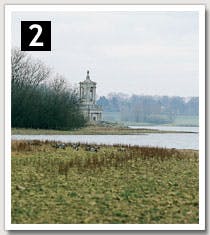
3) Two Trees
THIS famous spot used to be three trees but one has now been felled. A good cast from the bank here will hit deeper water. The shallow point further along the bank at Mowmires Reach is favourite with anglers searching the deeper water on the drop off to the left of the point. Also look out for the blue aeration pipes which leave the lake. This is another deeper spot that always holds trout, often resident fish. The bottom here is gravel and attracts brownies in autumn.
Best methods: Black Buzzers on floating line. Lures on an intermediate
Best times: Good all year
Wadeable? Limited
Wind effect: SW best
4) Dam Wall
HARDER to fish from than some dam walls due to its rocky boulder construction. You’ll need a line tray to prevent line damage. The Fantasy Island corner is the hotspot with no boats allowed within 100 yards. Food will accumulate in this corner after a North-westerly blow and attract trout. The Sykes Lane corner is the other hotspot. Overall, the dam wall fishes best early and late in the season – look out for fry-feeding brownies – but will hold fish all year. High back casts are essential to prevent fly damage.
Best methods: Boobies on a fast-sinking line early season; Pheasant Tail Nymphs in spring; Green Midge works well from June to September; Minkie on an intermediate at the back-end
Best times: All year
Wadeable? Don’t even think about it!
Wind effect: Tricky in a NW. Best in an SE. A due East back wind may cause leader tangle.
5) Sykes Lane
THIS popular bank mark holds fish all year, and after a recent stocking it can be hard to find bank space. Great buzzer water due to the shallow nymphs beds. But go to your right and you will find deeper water off the Monument. Search the weed beds on a Summer evening for resident rainbows. They will take a dry fly or nymph. In Autumn, Floating Fry patterns and Cat’s Whiskers will work when fished around the weed. Brown trout often shoal up here in the corner by the dam after the fry.
Best methods: Classic nymph water from Spring to Summer. Tadpoles, Damsels, Sparklers and Cat’s Whiskers will work from late Summer through to Autumn
Best times: Good all year
Wadeable? Yes
Wind effect: Best on SW or NE
6) Stockie Bay
DEEP water close to the shore here will hold fish in most weathers, hence the name. The bottom is rocky and there is no need to wade as the fish will feed close to the shore. The prevailing South-westerly wind blows into the Bay and, if the water remains clear, will produce good sport for anglers who can put up with casting into the wind.
Best methods: Tadpoles and Sparklers early season. Floating Fry and Minkies late season
Best times: April-June, September-December
Wadeable? Not necessary
Wind effect: Best on SW or NE.
7) Whitwell Creek
ONE of the most famous and popular bank spots on Rutland, especially at the start and end of the season. The shallow water at the top of the Creek always holds fish from opening day. And if a strong South-westerly is blowing straight into the creek when the fish are stocked, they will run straight up to the end of the creek. If the wind allows it, try the East bank nearer to the creek mouth. The point with the fence is a hot spot. Whitwell has produced some of Rutland’s biggest fish down the years as they leave the deeper water and move into the margins. Sailing activity makes Whitwell a difficult place to fish in Summer.
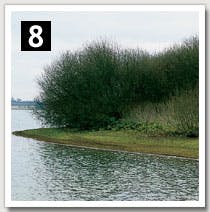
Best methods: Buzzers early season. Black and green Tadpoles in Autumn. Then Floating Fry and Minkies at the end
Best times: April-June, September-December
Wadeable? Not necessary
Wind effect: Protected from strong winds but gets crowded
8) Ernies Point
A NOTED reservoir hotspot as it offers easy access to deep water. A shallower point on the right-hand side attracts fish and a good cast will let the angler fish the shelves either side. A Westerly wind lets the angler fish his flies from right to left. Naturally, space is limited here and sail-boarders often launch from the shallower area. It also can colour up in a strong wind. When it’s clear, fish can be seen cruising the shallow bar. Noted for its brown trout at the end of the season.
Best methods: One of the reservoir’s top nymph spots. Mini lures and Tadpoles always worth a try
Best times: April-June, September-December
Wadeable? Not recommended as the bottom is very soft and will colour up the water badly
Wind effect: Light westerly or South-westerly best. But is exposed to strong winds.
NORTH ARM
9) Willow Bay
YOU don’t have to walk far from the car park to fish this stretch of bank. Although crowded with day trippers at weekends, the bank West of Ernie’s Point holds a good head of fish throughout the year. The now-disused stone jetty at Belgrano Bay gives access to deep water and the fish are close to the bank. Fish can also be taken either side and round into the shallower Willow Bay. Casting can be a problem at high water level because of the trees. Best spots are in front and in the deeper water to the west in front of the Mound
Best methods: Spanflex Buzzers under a “bung” on a floating line; Damsels and Tadpoles on intermediates and slow sinkers; Minkies on floaters
Best times: All year
Wading? No. Too deep
Wind effect: Easy to fish on a N/NE
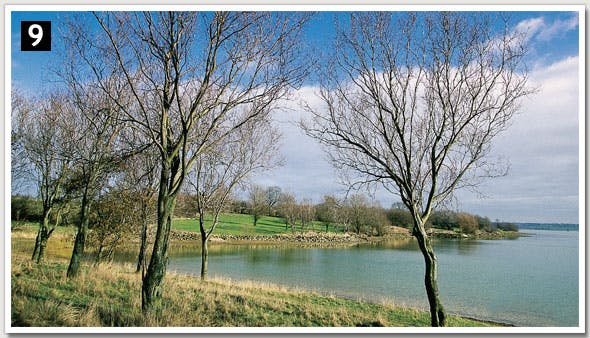
10) Barnsdale Creek
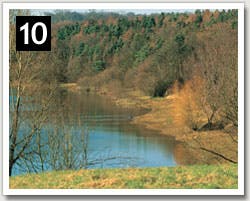
WHEN a big wind gets up on Rutland, the boats head for Barnsdale Creek. This protected piece of water holds fish all year, but is particularly good for nymphing in May and June. And you can catch fish on fry patterns here from the end of Summer right until the last day of the season. However, the bank angler can struggle to fish here because of the trees, which stretch right down to the water’s edge. One of the top spots is just inside the Bay in front of the hedge end. Space is limited here but increases as the levels drop. The bank opposite the wood can be good early season after stocking, while at the very end of the season some very big fish run up the creek right into the stream.
Best methods: Buzzers on a floating line; Damsels and Tadpoles on intermediates and slow sinkers; Minkies/ Floating Fry at the back-end
Best times: Spring/Autumn
Wading? No. Too soft underfoot
Wind effect: Sheltered from most strong winds, but the banks quickly fill up
11) Dickensons Bay
THE bank from Barnsdale to Dickensons is more the province of the boat angler, and can colour up very badly in a Westerly wind. However, the small bay at the boundary of the wood can produce well at buzzer time. If you drive down Barnsdale Hill past the Country Club, and park at the water’s edge, there is a short length of bank where you can reach deep water. To the left is a shallower bar that invariably holds trout. Into Dickenson’s Bay, there are two hotspots. If the water level drops sufficiently, you can wade out from the point to reach the deeper water, while the small point halfway along the bank (look for the tree stump) marks another deeper spot. The western bank is rather shallow and colours up quickly.
Best methods: Buzzers on floaters
Best times: All year
Wading? Limited
Wind effect: Easy to fish on most winds, especially N/NE
12) North Arm Shallows
IT’S the quality fishing with imitative patterns on these shallows for silver, grown-on rainbows that makes Rutland so special. Heavy weed growth around the margins can make it difficult for bank angling, but some of Rutland’s best fish spend late Spring and Summer browsing the North Arm weed beds. Here you will need to target moving fish in the shallow water, taking care not to scare them. A small CDC dry, Pheasant Tail, Diawl Bach Nymph or Corixa, presented on a long leader is the approach required. Take care you have plenty of backing as a fit four-pounder will quickly empty the reel. The limit of fishing is marked by bird-reserve warden Tim Appleton’s cottage where an old fish-pond wall is exposed by falling water levels. Fish can be found right up to the limit of fishing. Further right, the shallow bank area from the submerged road right round to The Transformer offers exciting fishing before it becomes too weeded up in late Summer.
Best methods: Buzzers, Damsels and Hare’s Ears on floating line. Diawl Bach is a killer here. Minkies at the back-end of the season
Best times: Spring/Autumn
Wading? Yes
Wind effect: Protected from strong Westerly winds

13) The Finches
LEAVE the Hambleton road onto the unmade track that runs around the peninsula, and the first anglers’ car park you come to is The Finchesmed after the public house that overlooks the reservoir at this point. This is a popular spot, espe¬cially with season-ticket holders, as deep water reaches close inshore, The small bay cannot hold many anglers but trout stocked at The Transformer hole up here, along with resident fish. The next car park along is known as Stumps Point, because of the felled tree stumps revealed at low water. All this bank is worth exploring, fishing the small bays and points, but it can colour up badly with a North-westerly or North-easterly blow.
Best methods: Spanflex Buzzers, Diawl Bachs, Pheasant Tails on floating lines. Damsels and Tadpoles on intermediates and slow sinkers. Minkies in autumn
Best times: All year, but fish may feed inshore at dawn and dusk during summer, retiring to the deeper water during the day
Wading? No. Too soft
Wind effect: Lovely bank to fish from on a Southerly
14) Armley Wood
THE Peninsula bank to the boundary of Armley Wood offers all sorts of exciting possibilities, provided it is not being scoured by a North-westerly or North-easterly wind. A number of small troughs, bays and ridges will all hold fish at times in Spring. Anglers car parks are provided at intervals along the peninsula track. When you arrive at the wood, the trees come right down to the water making a backcast impossible. The bottom is also snaggy with many tree stumps. However, go to the right of the wood and you will find deeper water close in. Move along the bank until you find the fish. This is a hotspot for the last two months of the season when the weed has died back and the trout are hard on the fry.
Best times: Spring/Autumn
Best methods: Black and green Tadpole and Minkies on intermediate lines
Wading? Limited as bottom is soft
Wind effect: Exposed to the wind so can colour up, but can fish here in a NW or SW
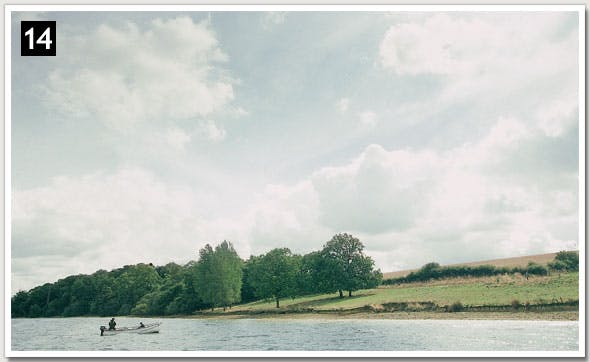
15) Carrot Creek
A FAVOURITE spot due to the deep water close to shore. The extensive weed beds hold fry and good fish are caught in autumn and winter. But you may need to cast a fair way to reach deeper water. The water here can colour up badly in a strong Northerly or North-westerly, or go very clear with a back wind. Try to fish near the weed beds, which may not be obvious except when you recover a piece of weed on your fly. The actual point of the bay is the most popular spot but fish can be caught all the way along the shore to the wood.
Best methods: Black and green Tadpole and Minkies on intermediate lines
Best times: Spring/Autumn
Wading? Not permitted as lake bed is too soft
Wind effect: Southerly wind is ideal but the surface may become too calm
16) Barnhill Creek
A VERY popular spot on the far end of the peninsula, it needs high water levels to draw the fish into this creek. The weed beds will attract fry but the area enjoys good sedge hatches on a Summer’s evening. The mixture of deep and shallow water attracts the fish, but sometimes the creek can be devoid of fish. The hawthorn bush halfway along the south bank is a good mark, as is the mouth of the creek on the North side. Well protected from a strong South-westerly or North-westerly wind
Best methods: Black and green Tadpoles, Minkies and Floating Fry in Autumn
Best times: Spring/Autumn
Wading? Too deep
Wind effect: The creek can remain clear when the rest of the North Arm is coloured by an onshore Northerly
SOUTH ARM
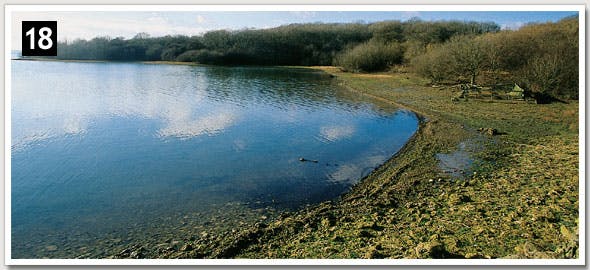
17) Inman’s Spinney
A GREAT early-season spot for stockies, which love the deep water close to the bank. With any type of back wind – Northerlies are common early season – the bank angler can reach deep water with a good cast. Spud Bay is the most popular spot. Three double-figure browns were once caught from this mark in a week. With high water, the bank angler doesn’t even need to get his feet wet. The lake bed is quite soft and silty and enjoys good hatches of midges, but many fish are caught here on lures and sinking lines. There are two small bays in front of the wood, fishable only at low water. These can hold fry feeders around the undergrowth. The steep banks from the wood to Yellowstone all hold fish at high water.
Best methods: Boobies on fast-sinking lines in spring. Then Damsels, Cat’s Whiskers and Sparklers on an intermediate
Best times: All season
Wading? Not permitted from the wood to Yellowstone
Wind effect: Well protected when the wind is from the North
18) Yellowstone Bay
THIS prolific shore mark is not the easiest place to find, hidden in the trees of Hambleton Wood. Yellowstone has two major points. The one with the no-wading sign is deep with a clay bottom. The other point that leads to the bay with the dead tree is a shallower bay with buzzer beds. This is the best point with deeper water to the left and shallower water to the right and holds fish all year, drawn there by buzzers and fry. Trout stocked at nearby Old Hall will often run into this Bay.

Best methods: Boobies on fast-sinking lines in spring. Then Damsels, Cat’s Whiskers and Sparklers on an inter¬mediate, or Buzzers on a floating line
Best times: All season
Wading? No
Wind effect: Well protected when the wind is from the North. Can colour up when the wind is blowing into the bay
19) Old Hall Point
ONE of the most obvious features at Rutland, this peninsula with its historic manor house is a magnet for anglers early season. And with good reason. At times rod after rod can be bent from this deep-water mark. The prime spots are the corners of the Point with the flies allowed to drift around in the breeze. But fish can be taken anywhere. Close to the car park is a deep hole, not evident at high water. The silty bottom here is rich in bloodworm and this hole surrounded by shallows is a natural holding spot. If you can’t get on the point, try casting into the deeper trough to the west of the point.
Best methods: Anything can work here from Boobies on a Di-8 to Buzzers fished under a “bung.” Don’t forget a Damsel fished on an intermediate cast well out
Best times: All season
Wading? No. Too deep
Wind effect: Cross breeze like a SW or NE is great
20) Green Bank
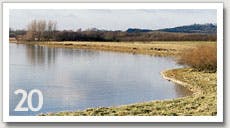
ANOTHER favoured area for the Rutland aficionados, who like the challenge of natu¬rally-feeding fish. This shallow water area at the top of the South Arm switches on in May and June when the buzzers start to hatch, but it needs the water level to be high. Parking is easy, but you need to be here early in the morning to enjoy the best sport. The bank fishing limit here is the fence. Halfway back towards the Point, you’ll find The Stones, a small point where you can reach deeper water.
Best methods: Strictly nymphs and dry flies on floating line
Best times: May, June, July
Wading? No
Wind effect: A Northerly back breeze will draw fish from deep water into the shallows
21) Berrybutts Spinney
GIBBET Gorse marks the limit of bank fishing. This is an exposed stretch of bank and can colour up badly in a Westerly wind. There is more shelter to be found at Berrybutts Spinney, but you need the water down to be able to fish in front of the trees. The next bay along is more popular with weed beds holding fish. The trout will shoal here early season when the wind is blowing into the bank, but you will need suit¬able gear to get the distanc





